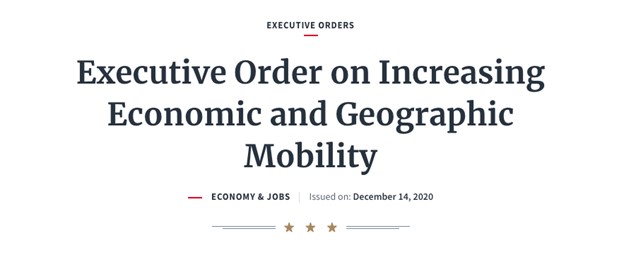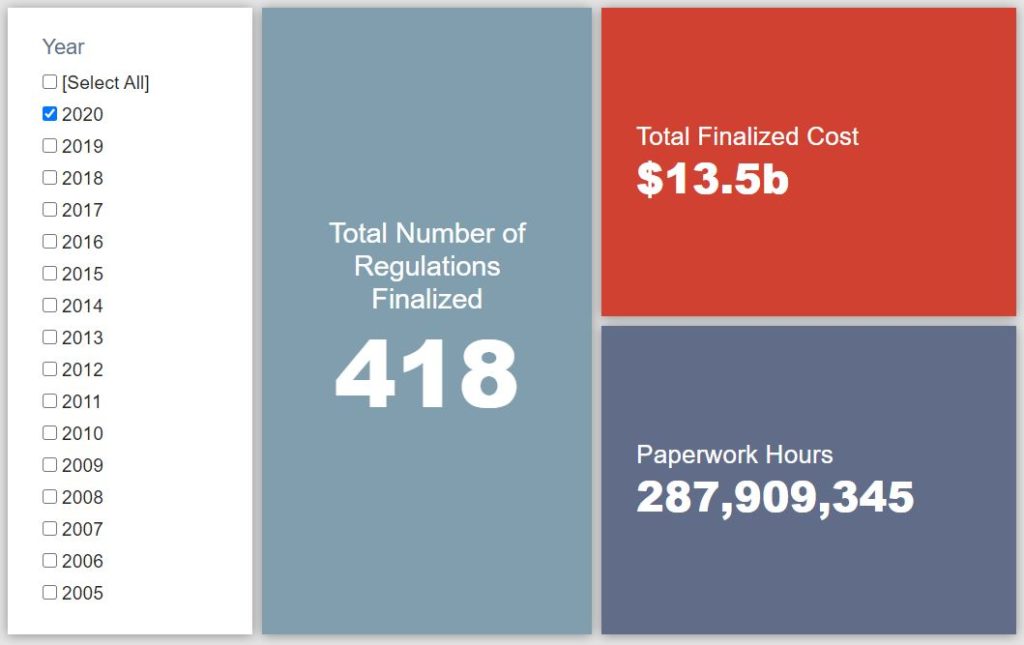Week in Regulation
December 21, 2020
Busy Week Leads to Net Costs
As 2020 begins to truly wind down, agencies added another chunk of costs. With 26 rulemakings that had some discernible economic impact, last week was an active one in the pages of the Federal Register. Notable topics included: electronic health care records for Medicaid patients, retirement plan advisors, and the emerald ash borer. Across all rulemakings, agencies published $2.6 billion in total net costs and added 6.5 million hours of annual paperwork.
REGULATORY TOPLINES
- Proposed Rules: 43
- Final Rules: 85
- 2020 Total Pages: 82,770
- 2020 Final Rule Costs: $13.5 billion
- 2020 Proposed Rule Costs: $20.4 billion
TRACKING THE REGULATORY BUDGET
The most significant rulemaking of the week was a proposed rule from the Department of Health and Human Services (HHS). This proposal seeks to “increase data sharing and reduce overall payer, provider, and patient burden through proposed changes to prior authorization practices.” While its stated purpose is to streamline and consolidate aspects of the health care system, HHS estimates that the administrative burdens in setting up this new framework would yield roughly $136 million in annual costs, or $1.9 billion in present value. Since it is a proposed rule, however, these costs do not apply to the fiscal year (FY) 2021 regulatory budget.
The most consequential rulemaking that does apply to the FY 2021 regulatory budget is a measure from the Department of Labor (DOL). The action is an “adoption of class exemption and interpretation” regarding investment advice standards under the Employee Retirement Income Security Act of 1974 (ERISA). DOL has determined that this is a deregulatory action since it “provides broader and more flexible exemptions that allow investment advice fiduciaries with respect to Plans and IRAs to receive compensation and engage in certain principal transactions that would otherwise be prohibited under Title I and the Code.” The agency only provides a qualitative description of these deregulatory benefits. In the quantitative sense, the rule brings annual net costs of $57 million (or $814 million in present value) because of the administrative burdens faced by newly covered entities in certifying their exemption status.
The most notable quantitatively deregulatory action is the Department of Agriculture’s (USDA) rule on the “Removal of Emerald Ash Borer Domestic Quarantine Regulations.” As the title suggests, the rule pulls back domestic quarantine requirements concerning the emerald ash borer, a “destructive wood-boring pest of ash (Fraxinus spp.) native to China and other areas of East Asia.” USDA has determined that, due to a variety of factors, the quarantine approach has largely failed to meet its goals and thus that it would be more prudent “to direct available resources towards management and containment of the pest” instead. The agency estimates that relieving affected entities of the quarantine’s requirements yields $18.8 million in annual savings (or nearly $269 million in present value).
While the administration’s FY 2021 regulatory budget caps are still forthcoming, so far into FY 2021 agencies have officially published 57 deregulatory actions and 16 regulatory actions (as defined by Executive Order (EO) 13,771), totaling $35 billion in quantified total net costs. It is worth noting at this point, however, that regardless of whether or not the current administration releases said caps, the Biden Administration assumes power in January 2021. It is highly unlikely that EO 13,771 will remain operative (at least in anything resembling its current form) beyond then, and thus the FY 2021 regulatory budget “window” will be a truncated one. Nevertheless, the American Action Forum (AAF) will continue to track EO 13,771 activity through the end of the administration to provide a record of the regulatory budget initiative’s historical legacy and implications. AAF’s review of the administration’s FY 2020 regulatory budget progress can be found here.
THIS WEEK’S REGULATORY PICTURE
This week, an executive order aimed at reducing occupational licensing hurdles.

Source: https://trumpwhitehouse.archives.gov/presidential-actions/executive-order-increasing-economic-geographic-mobility/
On December 14, President Trump signed an Executive Order on Increasing Economic and Geographic Mobility. The EO establishes principles for reducing occupational licensing requirements nationwide and requires agencies to take steps to identify such requirements within their own regulations.
As defined in the EO, occupational licensing requirements are those that require a license, registration, or certification in order to perform certain defined services for compensation. While many such requirements are in place allegedly to protect consumers from being taken advantage of, the growth in the number of requirements instead tends to protect incumbent businesses and prevent individuals from being able to earn a living in their specialty if they move to a new state. According to the EO, the percentage of jobs requiring a government-mandated occupational license has increased from less than 5 percent to between 25 and 30 percent since the 1950s.
Since most of these requirements are imposed at the state and local level, however, the EO is limited in its ability to affect direct change. Instead, the order sets out a list of six principles that the federal government will support in order to reduce unnecessary licensing requirements nationwide. These principles include: the active supervision of occupational licensing boards by a designated government office, that such boards should adopt minimally restrictive requirements, and that local governments should review their licensing requirements.
The EO also takes steps to address licensing requirements that are exacerbated by federal regulatory requirements. Per the order, agencies are to review their regulations to see which unnecessarily reinforce occupational licensing requirements. A government-wide report on recommendations to reduce the requirements is due within four months (assuming the EO is not repealed or modified by the incoming Biden Administration).
While the language of the EO is an encouraging sign of increased momentum to reduce needless licensing requirements, its ultimate effect will likely be quite limited. The Obama Administration issued a similar report in 2015 that failed to spur significant action nationwide.
TOTAL BURDENS
Since January 1, the federal government has published $33.9 billion in total net costs (with $13.5 billion from finalized rules) and 352.8 million hours of net annual paperwork burden increases (with 287.9 million hours due to final rules). Click here for the latest Reg Rodeo findings.












